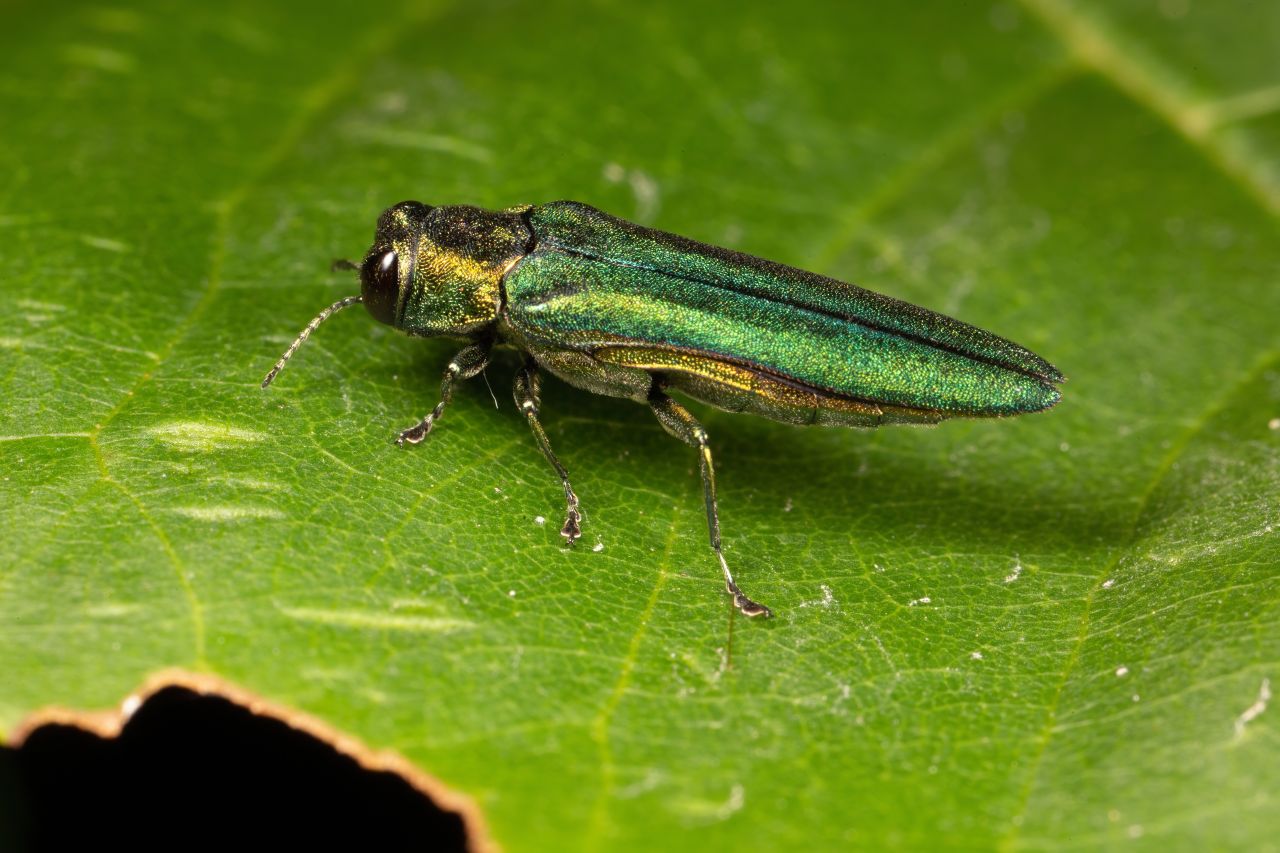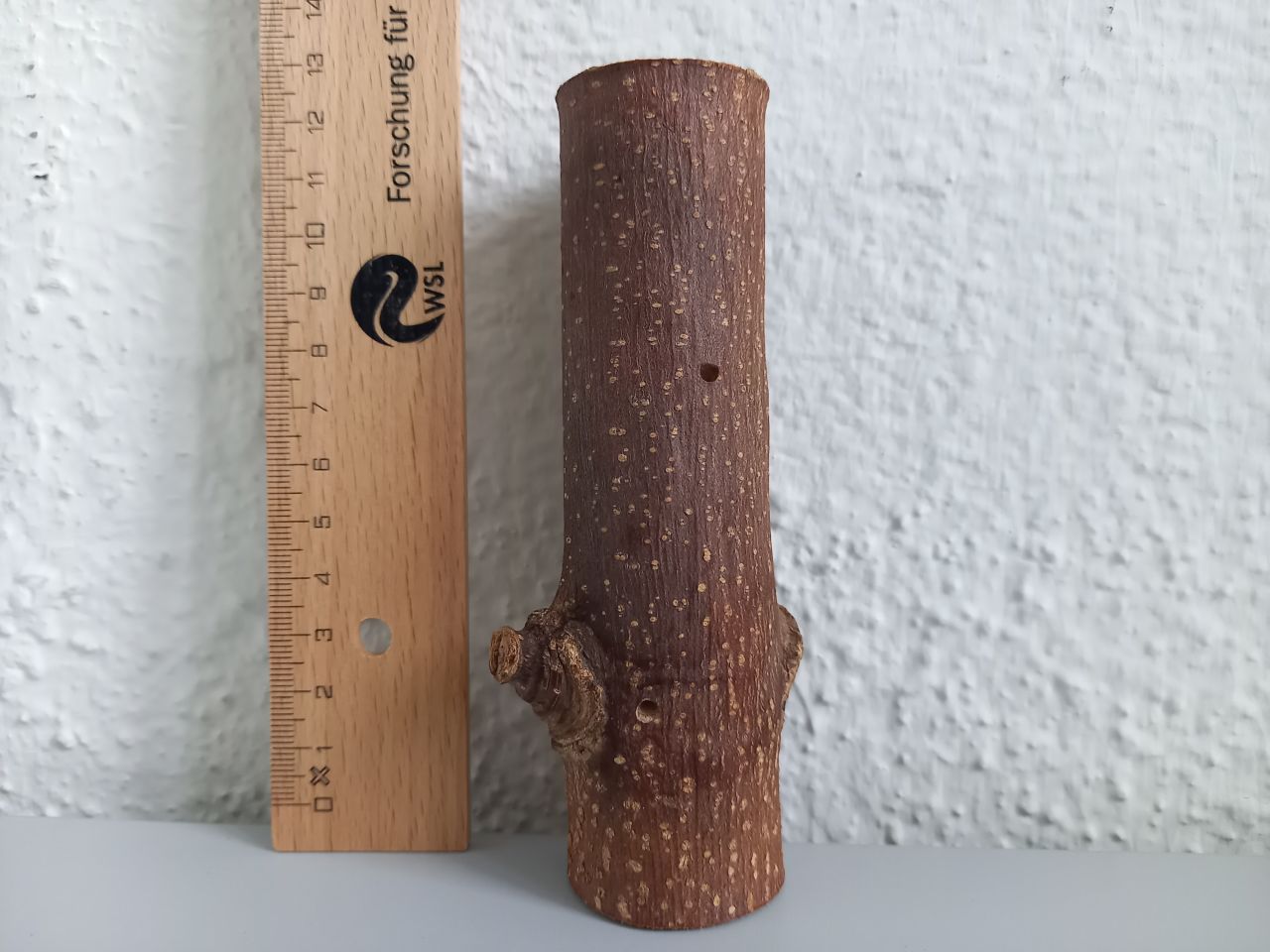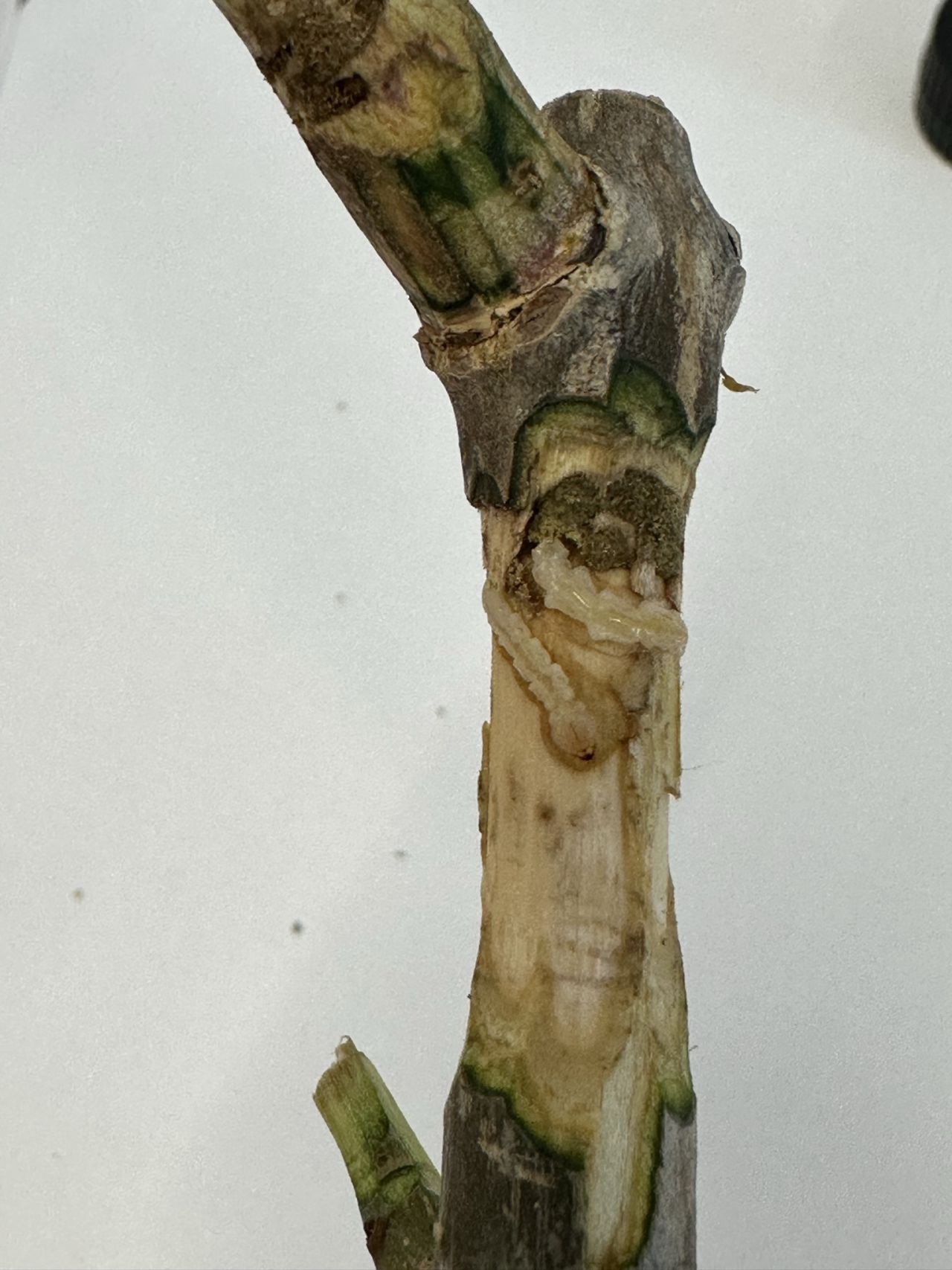Sparkling nightmare for ash trees - Emerald ash borer
Like small green jewels, emerald ash borer beetles sparkle on leaves in the incubators of the plant protection lab at the Swiss Federal Institute for Forest, Snow and Landscape Research (WSL). Although they are pretty, they cause substantial ecological and economic damage to areas where they have been introduced.

Emerald ash borer (Agrilus planipennis) on a leaf. Image: Adobe Stock
Profile
- Adult emerald ash borers (EAB) are metallic green, slim bodied, 8.5 – 14 mm long, with darker green or copper-hued elytra.
- They have a copper red upper abdomen (visible with wings spread).
- EAB are often confused with other beetle species by non-experts.
- They are natively found in temperate regions of northeastern Asia, including Mongolia, China, Japan, and Korea, but they are invasive in North America and are spreading into Europe.
- Emerald ash borers cause significant damage to ash trees in the regions they invade, where the tree species lack natural defenses against them.
Classification
- Kingdom
- Animalia
- Phylum
- Arthropoda
- Class
- Insecta
- Order
- Coleoptera
- Family
- Buprestidae
- Genus
- Agrilus
- Species
- Agrilus planipennis
Life cycle
The emerald ash borer's life cycle varies between one and two years, depending on factors like temperature, tree health, and the timing of egg-laying, with a two-year cycle being more typical in colder regions. Adults emerge in late spring after warm weather, feed on the margins of ash leaves for approximately a week without causing much damage to the tree and then mate. Females typically live three to six weeks, laying 40–70 eggs, though some may lay up to 400. Eggs are laid in the cracks of ash bark, hatch in two weeks, and larvae burrow into the tree to feed, creating serpentine galleries under the bark. Larvae progress through four instar* stages and overwinter in a dormant state. In spring, they pupate for about 20 days and emerge as adults.
What's the problem?
Adult emerald ash borers (EAB) lay eggs in the crevices and cracks of their host trees (Fraxinus spp.). Larvae emerge from these eggs and burrow through the bark into the tree. The larvae feed on the cambium and vascular tissue, which cuts off the essential flow of nutrients and water in the tree through the phloem* and xylem. This can girdle* and kill the tree. Once the worm-like larvae have passed through 4 instar phases, they pupate in the sapwood. The beetles emerge as adults from D-shaped holes in the bark, crawl up to the canopy to complete maturation feeding on the foliage, before mating and dispersing by flying to new hosts.

D-shaped exit hole in the bark, created by an emerging emerald ash borer beetle. Image: © A. Perret Gentil
Tiny creatures of mass destruction

Bark peeled away to expose an emerald ash borer larva feeding on an ash sapling. Image: © Julia Kappeler
Although emerald ash borers only attack weakened ash trees in their native range of northeastern Asia, they can infest and kill mature and healthy trees in areas where they have been introduced by humans. Ash species that have co-evolved with the beetle have developed chemical defences, while ash species which have not previously been exposed to this insect are ill prepared to fend off this enemy.
EAB has become the number one most destructive forest pest in north America, in some cases killing more than 99% of ash trees in a stand and leaving ghost forests in their wake. EAB was first recorded in 2002 near Detroit, Michigan. The beetles were probably introduced to the eastern part of the continent in the 1990s, likely arriving as stowaways in wood packaging of shipped goods. Forest pests often travel in wood products or nursery trees transported from one area to another.
Advancing toward western Europe
As of early 2025, these beetles have not yet reached Switzerland, but their arrival is inevitable. In 2003, they were discovered in western Russia and have steadily spread toward western Europe. With no geographical boundaries, and a continuous presence of suitable host trees, they will likely make their way to Switzerland through natural dispersion. Ash trees are keystone species in European forests and one of the most common deciduous trees in Switzerland. Hence, protecting these trees from non-native pests such as the EAB is vital to maintain healthy ecosystems.
A keystone species under threat and the quest to protect it
Emerald ash borers are just one of many threats to European ash trees. In Switzerland, ash trees are already at risk from the fungal pathogen Hymenoscyphus fraxineus that causes ash dieback disease. Ongoing research at WSL is focused on identifying characteristics of native European ash (Fraxinus excelsior) that confer resistance to both EAB and ash dieback disease. The DefendAsh team at WSL is studying the role of genetic variation within the species, and how factors like drought stress interact with EAB and ash dieback.
The lab is investigating chemical ecology*-based factors to understand why some ash genotypes are more resistant to EAB than others. This involves analyzing plant chemicals, more specifically volatile and non-volatile specialized metabolites: compounds that are released from leaves into the air, and compounds within the leaves and phloem*.
Tree resistance to EAB is assessed by observing how well the beetle larvae develop under the bark of certain ash genotypes, each with a slightly different chemical profile. Saplings are infected with EAB eggs, from which larvae hatch and are allowed to develop. The larvae are then retrieved by peeling back the bark. The instar stage of each larva is determined by measuring the peristomal* width. Each larva is then dried and weighed to evaluate its growth.
The results of the DefendAsh team give reason for optimism as they show that trees less affected by ash dieback show increased resistance against EAB larvae. This cross-resistance suggests that trees surviving ash dieback disease may also be better equipped to withstand EAB infestations.
Identifying resistant European ash genotypes and understanding the traits that make them more resilient to EAB can help produce resistant saplings to plant future forests that would be better adapted to withstanding these introduced threats.
EAB fun facts
- Although male and female beetles look very similar, they can be distinguished by the more densely golden haired chest of male beetles.
- Emerald ash borers can likely “smell” host trees with their antennae, which sense chemicals in the air. Electrical impulses are triggered when the antenna comes into contact with specific volatile ash compounds.
- Scientists at WSL are collaborating to develop emerald ash borer detection programs using sniffer dogs. Dogs are already trained to detect other invasive forest pests, such as the Asian long-horned beetle (Anoplophora glabripennis).
- Augmented biocontrol, which uses natural enemies native to the area where a pest has been introduced, may be a potential strategy for controlling emerald ash borer in Switzerland. The main natural enemy under investigation are parasitoid wasps. These wasps often specialize on a single insect host, and lay eggs inside them, which results in the eventual death of the host.
*Glossary
Chemical ecology: An interdisciplinary field that combines biochemistry, biology, ecology, and organic chemistry to study how living organisms interact with their environment through chemical signals. It explores phenomena like ecosystem resilience and biodiversity.
Girdle: If a several-centimeter-wide strip of bark is removed all around the tree down to the cambium - whether intentionally as part of forestry measures or due to feeding damage - the tree can no longer be supplied nutrients and dies.
Instar: Developmental stages of immature arthropods between molts (shedding).
Peristoma: The outer border of the mouthparts.
Phloem: The living tissue in plants that transports sugars and other nutrients to different parts of the plant. In trees, the phloem is the innermost layer of the bark.
Elytra: The hardened forewings of beetles that protect the hindwings and abdomen but are not used for flight.
Cambium: A thin layer in plants that makes new cells to help the stem or root grow thicker.
Phloem: The plant tissue that carries sugars and other organic compounds from the leaves to the rest of the plant.
Selected References
Cappaert D et al. 2005. Emerald Ash Borer in North America: A Research and Regulatory Challenge. American Entomologist, 51(3): 152–165. https://doi.org/10.1093/ae/51.3.152
Gossner MM et al. 2023. A glimmer of hope – ash genotypes with increased resistance to ash dieback pathogen show cross‐resistance to emerald ash borer. New Phytologist, 240(3): 1219–1232. https://doi.org/10.1111/nph.19068
Kappeler J. 2023. Implications of Intraspecific Variation in European Ash (Fraxinus excelsior) for Emerald Ash Borer (Agrilus planipennis) Feeding Behaviour and Reproductive Success. [Unpublished master's thesis]. ETH Zürich
Knight KS et al. 2012. Dynamics of Surviving Ash (Fraxinus spp.) Populations in Areas Long Infested by Emerald Ash Borer (Agrilus planipennis). In: Sniezko RA et al. 2011. Proceedings of the 4th international workshop on the genetics of host-parasite interactions in forestry: disease and insect resistance in forest trees; Eugene, OR. Gen. Tech. Rep. PSW240. Albany, CA: U.S. Department of Agriculture, Forest Service, Pacific Southwest Research Station: 143-152.
Orlova-Bienkowskaja MJ & Bieńkowski AO 2022. Southern Range Expansion of the Emerald Ash Borer, Agrilus planipennis, in Russia Threatens Ash and Olive Trees in the Middle East and Southern Europe. Forests, 13(4): 541. https://doi.org/10.3390/f13040541
Showalter D N et al. 2018. Strategic Development of Tree Resistance Against Forest Pathogen and Insect Invasions in Defense-Free Space. Frontiers in Ecology and Evolution, 6: 124. https://doi.org/10.3389/fevo.2018.00124
Wang X-Y et al. 2010. The Biology and Ecology of the Emerald Ash Borer (Agrilus planipennis) in China. Journal of Insect Science, 10(128): 1–23. https://doi.org/10.1673/031.010.12801






